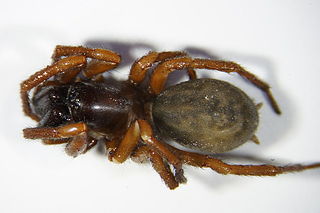
Tegenaria is a genus of fast-running funnel weavers that occupy much of the Northern Hemisphere except for Japan and Indonesia. It was first described by Pierre André Latreille in 1804, though many of its species have been moved elsewhere. The majority of these were moved to Eratigena, including the giant house spider and the hobo spider.

Zodarion is a genus of ant-eating spiders from the family Zodariidae. 169 species from Eurasia, North Africa and North America have been described as of November 2022.

Amaurobius is a genus of tangled nest spiders that was first described by Carl Ludwig Koch in 1837.
Troglohyphantes is a genus of sheet weavers that was first described by G. Joseph in 1881. The genus name is a combination of the Ancient Greek τρώγλη, meaning "cave (dweller)", and -hyphantes, a common ending for linyphiid genera.

Harpactea is a genus of woodlouse hunting spiders that was first described by W. S. Bristowe in 1939. They are non-web building predators that forage on the ground and on tree trunks at night, mainly in xerothermic forests. During the day, they hide in silk retreats they build under rocks or bark.

Coelotes is a genus of funnel weavers first described by John Blackwall in 1841. A large number of species are found throughout Europe and Asia.

Histopona is a genus of funnel weavers first described as a sub-genus of Hadites by Tamerlan Thorell in 1870. It was elevated to genus by Brignoli in 1972.
Urocoras is a genus of funnel weavers first described by S. V. Ovtchinnikov in 1999.

Gnaphosa is a genus of ground spiders that was first described by Pierre André Latreille in 1804. They all have a serrated keel on the retromargin of each chelicera.

Zora is a genus of spiders in the family Miturgidae, consisting of small to medium entelegyne, ecribellate spiders. They can be identified as they have two claws with claw tufts, distinct longitudinal bands on the cephalothorax, 4-2-2 arrangement of the eight eyes and long overlapping spines on the first two tibiae and metatarsi. Their abdomens show distinct colour patterns which may be useful in identification to species. There are 17 species in the genus which have a Holarctic distribution, mostly in Europe and the Middle East but with two species in North America. The type species is Zora spinimana.
Alloclubionoides is a genus of Asian funnel weavers first circumscribed by K. Y. Paik in 1992.
Himalcoelotes is a genus of Asian funnel weavers first described by X. P. Wang in 2002. They are mostly found in China and Bhutan.
Tegecoelotes is a genus of Asian funnel weavers first described by S. V. Ovtchinnikov in 1999.

Brachythele is a genus of spiders in the family Nemesiidae. It was first described in 1871 by Ausserer. As of 2022, it contains 10 species from eastern Europe.

Centromerus is a genus of dwarf spiders that was first described by David B. Hirst in 1886.

Heriaeus is a genus of crab spiders that was first described by Eugène Louis Simon in 1875.
Troglocoelotes is a genus of east Asian funnel weavers. It was first described by B. Li, Z. Zhao and C. T. Zhang in 2019, and it has only been found in China.











